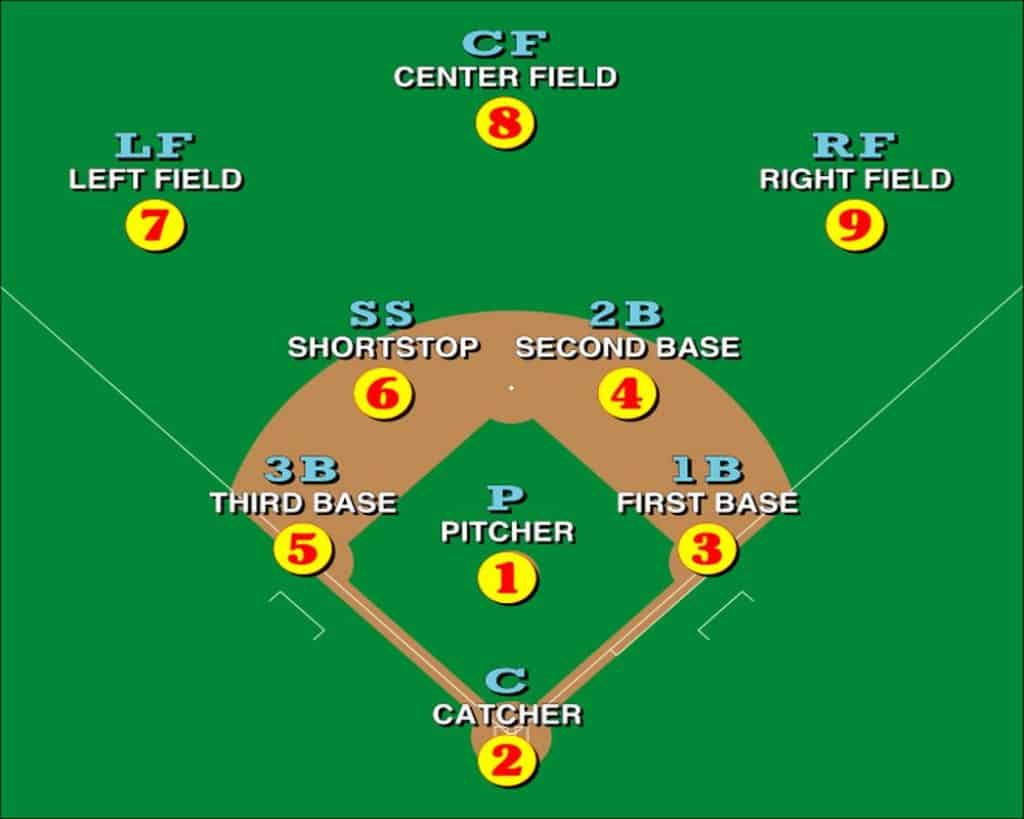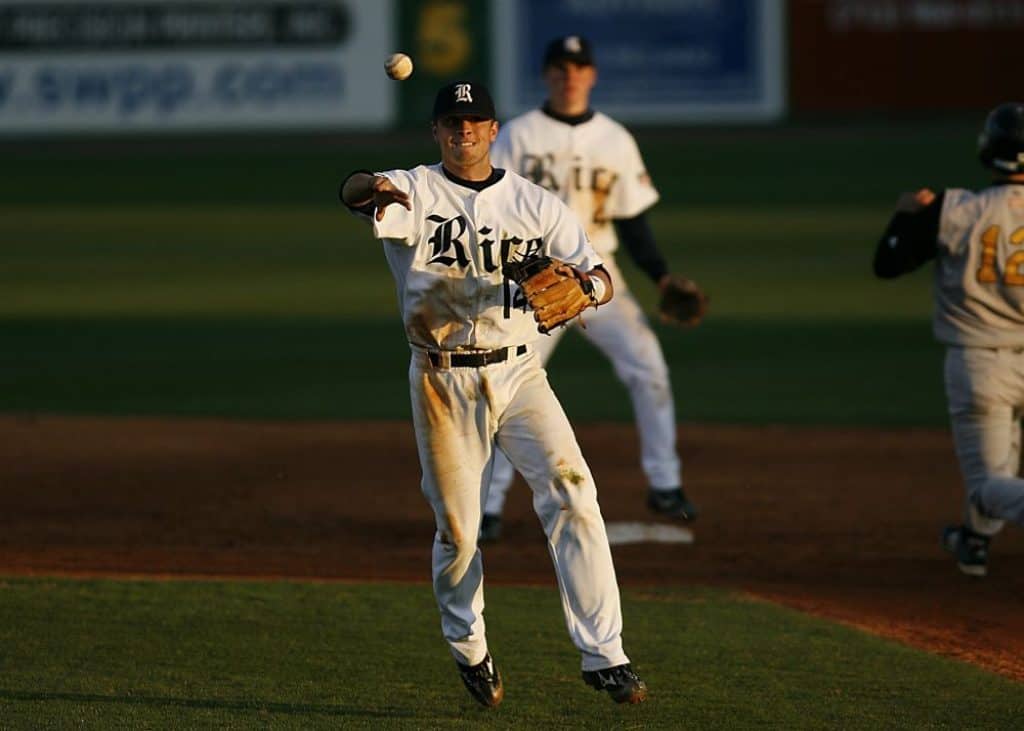6+4+3=2 In Baseball (Double Play Explained)
To record everything that happens on the field, scorekeepers use a fairly complicated system of symbols and numbers.
To those who are relatively new to baseball, this can often seem too confusing or overwhelming.
When watching a ballgame, you’ll often hear an announcer describing the play that just occurred (a double play, for example) using only numbers.
Also, box scores usually feature multiple columns marked only with different symbols or abbreviations.
In addition, you’ll often see baseball fans wearing shirts with numbers and math formulas, such as 6+4+3=2, that may seem random to the uninitiated.
However, once you get behind the numbers and learn what they mean, all this becomes quite simple to understand.
Plus, it opens up a whole new dimension of following the game and helps you keep track of every play.
Below, I’ll explain what is 6+4+3=2 in baseball and how this and other double plays are scored.
Table of Contents
What Does 6+4+3=2 Mean In Baseball?
To understand what is 6+4+3=2 in baseball, you should first learn what those numbers even mean.
To make the scorekeeper’s job easier, every defensive position on the field is assigned a number, so they don’t have to use players’ names when describing each play.
Baseball Position Numbers

The numbers for each position are:
1 = Pitcher
2 = Catcher
3 = First Base
4 = Second Base
5 = Third Base
6 = Shortstop
7 = Left Field
8 = Center Field
9 = Right Field
So, when describing a double play, scorekeepers and announcers use numbers associated with players to tell us who was involved in a play and the order in which certain events happened.
6-4-3 Double Play
In modern baseball, 6-4-3 is probably the double play that occurs with most frequency during games.
Knowing that the numbers marking the double play are associated with the player position and the order of events, it’s pretty easy to figure out how this one plays out.
In 6-4-3 double play, the shortstop (6) is the first to field the ball.
He then throws it to the second baseman (4), covering the second base, who tags the base and forces the first out on the runner coming from the first.
The second baseman then tosses the ball to the first baseman (3) who forces out the batter (second out).
As you can see, because of the order of the numbers, we can easily identify how the events unfolded during this double play.
When this double play occurs, the shortstop is credited with an assist, the second baseman with a putout and assist, while the first baseman gets a putout.
6+4+3=2
The frequency with which 6-4-3 double play occurs gave birth to the expression 6+4+3=2 which is nothing more than this double play told through math symbols, indicating that the ball went from shortstop (6) to second (4) to first (3) resulting in 2 outs.
The saying has become quite popular among baseball fans and can often be seen printed on T-shirts.
What’s The Most Common Double Play In Baseball?

In general, most double plays in baseball occur when the batter hits the ground ball. Usually, around 90% of double plays come after the ground ball goes toward an infielder.
Among those situations, the most common is, as noted above, 6-4-3 which I already described. For example, out of 1,386 double plays in the shortened 2020 season, 482 were of this type.
Other double plays that occur quite regularly are 4-6-3 and 5-4-3.
4-6-3 Double Play
During a 4-6-3 double play, the second baseman (4) fields the ball after it’s been hit by a batter, then throws it to the shortstop (6) who tags the base and forces an out at the second, before tossing the ball to the first baseman (3) who gets the batter out at the first base.
To get an idea of how often this type of double play happens, for every 100 6-4-3 DPs, there are 83 going 4-6-3.
5-4-3 Double Play
The third most frequent double play in baseball is 5-4-3, also known as the “around the horn” double play.
This combination happens when the third baseman (5) fields the ball and then throws it to lead the runner out of the second with second baseman (4) covering the base.
Finally, the second baseman throws the ball to the first baseman (3), getting the batter on first out. For every 100 6-4-3 double plays, there are 53 going 5-4-3.
What Is The Rarest Double Play In Baseball?
Double plays can occur in an almost unlimited number of ways and can involve various combinations of fielders.
In rare situations, they can even include an outcoming as a result of interference or an appeal play.
However, out of regular double plays, 3-6-4 is probably the rarest. For every 100 6-4-3 double plays, there’s only one 3-6-4 DP.
It happens when the runner is on the first and the first baseman (3) fields the ground ball and tosses it to the shortstop (6) for the first out and then the shortstop throws to the second baseman (4) on the first for the second out.
This play is so rare because it can only happen when the batter lays down a bunt, as that’s when the second baseman covers the first base.
So, for it to occur, the runner has to be on the first and not second, the hitter needs to lay down a bunt, and the first baseman has to cleanly field that bunt.
Conclusion
The ballgame’s final score tells us how many runs each team scored and it’s all we need to know who won the game.
However, it hardly tells us the story of the whole game.
Before we get to the final score there is a whole lot going on during the 9 innings of play and keeping track of all that is far from easy.
So, scorekeeping is often considered an integral part of the game. Scorekeepers help us understand everything that happened during a ballgame.
However, detailing every play, especially those as complex as double plays, is often complicated. That’s why they use numbers assigned for each position as a shorthand to keep things simple.
When you know what number represents each position, understanding different types of double plays and how they unfold becomes much easier.




